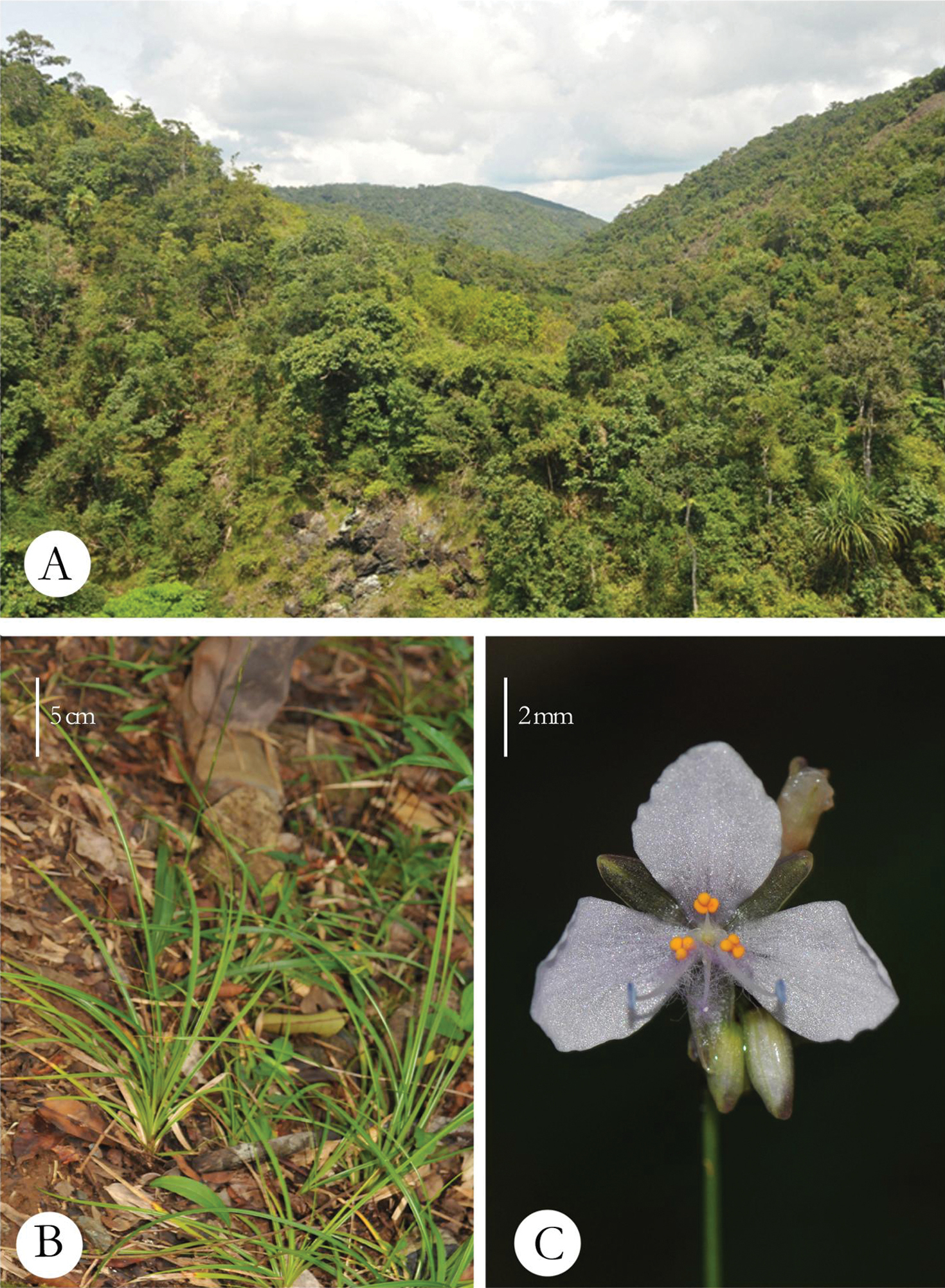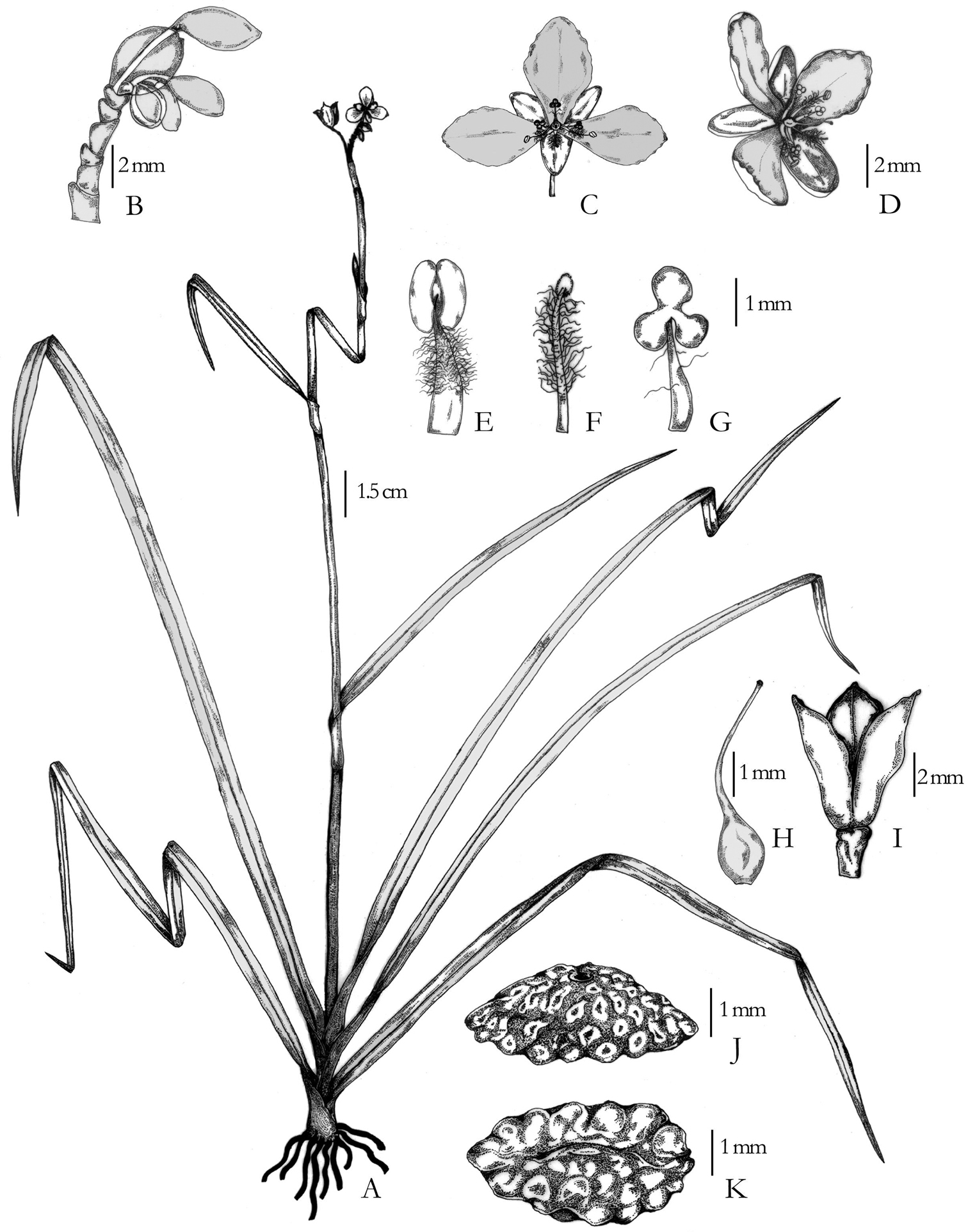






(C) 2013 M. Venkat Ramana. This is an open access article distributed under the terms of the Creative Commons Attribution License 3.0 (CC-BY), which permits unrestricted use, distribution, and reproduction in any medium, provided the original author and source are credited.
For reference, use of the paginated PDF or printed version of this article is recommended.
Murdannia saddlepeakensis (Commelinaceae), a new species from the Andaman and Nicobar Islands, India, is described and illustrated. The new species is remarkable for its narrowly linear leaves, two fertile stamens, single seeded locule and scorbiculate seeds.
Commelinaceae, Murdannia saddlepeakensis, new species, Andaman and Nicobar Islands, India
The genus Murdannia is represented by 54 species (
The Andaman and Nicobar Islands harbour luxuriant lowland rainforests besides wetlands, mangroves and coral reefs. The floral elements of these Islands often show close affinity with that of Indonesia, Malaysia, Myanmar, Thailand and Sri Lanka. Saddle Peak National Park which is located in the North Andaman Islands harbours unique stunted evergreen vegetation that is found only in restricted localities of the Andaman Islands (
During a recent botanical excursion, we came across an interesting specimen of Murdannia in an open scrub forest of Saddle Peak National Park. The specimens were collected and critically studied. It was found that the specimens did not match any of the known species of the genus and hence have been described and illustrated here as a novelty. In addition, a key for Murdannia species of Andaman and Nicobar Islands and some other species similar to Murdannia saddlepeakensis has been provided to facilitate identification.
urn:lsid:ipni.org:names:77124862-1
http://species-id.net/wiki/Murdannia_saddlepeakensis
Figs 1, 2India. North Andaman: Saddle Peak National Park, open scrub forests (Fig. 1-A), 13°09'N, 93°01'E, at 508 m, 18 November 2011, M.V.Ramana 0550 (holotype: CAL; isotypes: US, BSI, SUK, PBL).
Erect, 40–60 cm high, glabrous perennial with a basal rosette of leaves (Fig. 1-B); roots fibrous, 2–4 cm long and 2 mm in diam. Leaves rosette, sheaths 0.5–1 cm long, lamina narrowly linear, 20–60 cm long, 0.4–0.8 cm wide, apex acuminate, base rounded merged into the sheath, margins entire; cauline leaves with sheaths 0.2–2 cm long, glabrous, narrowly lanceolate to linear, 1–25 cm long, 0.2–0.5 mm wide, base rounded, apex acute to acuminate, glabrous, margin entire, often scabrid; flowering shoot terminal in the basal rosette, erect, 20–40 cm long, unbranched or rarely branched from apically reduced cauline leaves (a bract). Inflorescence terminal and axillary (from uppermost foliaceous bract) of peduncled cincinni (Fig. 2–B); peduncles 2–7 cm long, glabrous, cincinni to 2 cm long, few flowered, bracteoles 5 mm long, caducous. Flowers bisexual (Fig. 1–C; Fig. 2–C, D), c. 1.5 cm wide, opening 1230–1600 hr; pedicels (2–) 3–5 mm long (not declinate in capsule); sepals elliptic to oblong elliptic, 5–6 mm long, pale white to green; petals ovate to obovate, lilac to pale lavender; stamens 2 (Fig. 2E), filaments densely bearded, (3–) 4 mm long, anthers elliptic, c. 1 mm long; staminodes 3 (Fig. 2G), antepetalous with glabrous to sparsely bearded filaments, antherodes tri-lobed, yellow; one rudimentary stamen, antisepalous (Fig. 2F) with densely bearded filament ending with sterile knob; ovary glabrous; style recurved towards staminodes, (3–)4 mm long; stigma simple. Capsule subglobose, 4–5 mm long, 3 mm wide, locules 1-seeded. Seeds (Fig. 2J, K) elliptic or rarely ovoid, 2.5–5 mm long, 1.5–3 mm wide, testa scorbiculate on all surfaces, the depressions often partially uniting on the dorsal surface, forming a little larger, irregular depressions, dark brown, hilum linear or oblong-linear, embryotega dorsal-semidorsal, farinose sparsely in all depressions and around the embryotega.
Murdannia saddlepeakensis A Habitat (a view of Saddle Peak National Park) B Habit C Flower, ventral view.
Murdannia saddlepeakensis A Habit B Inflorescence C Flower, ventral view D Flower, lateral view E Stamen F Rudimentary stamen G Staminode H Pistil I Capsule J Seed, lateral view K Seed, ventral view. All from M V Ramana 0550. Drawn by Mayur Nandikar
Murdannia saddlepeakensisis so far only known from Saddle Peak National Park, North Andaman Islands, India.
It grows in an open scrub forest in rocky situations at an elevation of 508 m. The common associates are Sonerila andamanensis Stapf & King (Melastomataceae), Ophiorrhiza mungosL.(Rubiaceae) and Gomphostemma javanicum(Blume)Benth. (Lamiaceae). It was observed flowering and fruiting from October to February.
Etymology. Murdannia saddlepeakensis is named after the type locality Saddle Peak National Park. It is the highest peak of the entire archipelago, reaching an altitude of 732 m.
Murdannia saddlepeakensis was collected only once from the Saddle Peak National Park (North Andaman Islands). At this site c. 25 individuals in an open scrub forest in rocky situations were observed and hence it is assumed to be rare. However, larger part of the National Park is unexplored due to human inaccessibility. Therefore, the species can be accessed as “Data Deficient” (DD), using the criteria of
Murdannia saddlepeakensis belongs to the group Terminatae G. Brückn. (173: 1830) [Inflorescence terminal, many-flowered, the main shoot and lateral flowering shoots few to several, shortened, completely tufted]. In India, series Terminatae is represented by eight species viz. Murdannia dimorpha G. Brückn., Murdannia divergens (C.B. Clarke) G. Brückn., Murdannia hookeri (C.B. Clarke) G. Brückn., Murdannia japonica (Thunb.) Faden, Murdannia gigantea (Vahl) G. Brückn., Murdannia loriformis (Hassk.) R.S. Rao & Kammathy, Murdannia nudiflora (L.) Brenan and Murdannia simplex (Vahl) Brenan (modified after Brückn. 1930). The first four species have more than two seeds per locule and rest four have two seeds per locule while Murdannia saddlepeakensis has single seed per locule.
Murdannia saddlepeakensis closely resembles Murdannia simplex but can be easily distinguished by its narrow linear leaves, terminal flowering shoot in the basal rosette, glabrous leaf sheaths, single seeded locule, elliptic seed with scorbiculate surface. In addition, Murdannia saddlepeakensis is restricted to northern Andaman Island whereas Murdannia simplex is much more wide spread in Tropical Africa and Asia. Murdannia gigantea with a terminal flowering shoot also is similar to Murdannia saddlepeakensis but differs in having thick, fibrous roots, broad leaves, three stamens and seeds with dorsal embryotega. Murdannia saddlepeakensis can also be mistaken for the widespread Murdannia loriformis in general. However, the presence of erect, terminal flowering shoot and scorbiculate, single seeded locule along with anthesis by noon supports its distinctness.
| 1 | Plants with basal rosette leaves | 2 |
| – | Plants without basal rosette leaves | 5 |
| 2 | Rosette leaves 0.4–0.8 cm wide; capsule subglobose; locule one seeded | Murdannia saddlepeakensis |
| – | Rosette leaves (0.5–) 0.8–1.5 cm wide; capsule ovoid to ellipsoid; locule two seeded | 3 |
| 3 | Flowering shoots terminal in the rosette; seeds ovoid to ellipsoid, 2.5–4 ×2–2.5 mm, hilum linear | Murdannia gigantea |
| – | Flowering shoots lateral in the rosette; seeds ovoid to obovoid, 1.6–2 × 1.5 mm, hilum linear to oblong | 4 |
| 4 | Pedicels 3–5 mm long; seeds 1.5–2 mm long; flowers 12–15 mm wide, opening after noon | Murdannia simplex |
| – | Pedicels 2–3 mm long; seeds 1.4–1.8 mm long; flowers 9–12 mm wide, fading by noon | Murdannia loriformis |
| 5 | Leaves subtending inflorescence bract-like; capsule globose; locule one seeded | Murdannia vaginata |
| – | Leaves not subtending inflorescence bract-like; capsule ovoid to obovoid or elliptic; locule more than 2 seeded | 6 |
| 6 | Leaves linear-lanceolate to linear-oblong; seeds 2 per locule | Murdannia nudiflora |
| – | Leaves lanceolate to ovate; seeds 3–7 per locule | Murdannia spirata |
The work was undertaken as a part of the project titled “Quantitative Assessment and Mapping of plant resources of Andaman and Nicobar Islands” funded by DBT, Ministry of Science & Technology, Government of India. MN thanks Dr. Robert B. Faden, Smithsonian Institution, Washington DC for his primary comments, Prof. S. R. Yadav and Manoj Lekhak, Department of Botany, Shivaji University, Kolhapur for critical going through the manuscript. Open access to this paper was supported by the Encyclopedia of Life (EOL) Open Access Support Project (EOASP).

